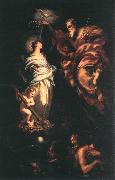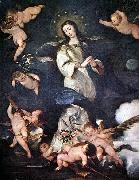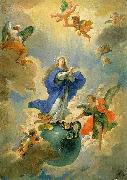Wholesale Oil Painting No Minimum |
|||||||||||
|
|
|||||||||||

|
|||||||||||
|
|
|
||||||||
PIOLA, DomenicoItalian Baroque Era Painter, 1627-1703 was a Genoese painter of the Baroque period. His family studio was highly prolific. He apprenticed with his family, including his elder brother, Pellegro Piola, as well as with Domenico Fiasella. Other members of the Piola family, who were artists included Domenico's brother, Giovanni Andrea and his three sons Paolo Gerolamo, Anton Maria, and Giovanni Battista; his two sons-in-law, Gregorio de Ferrari and Domenico Parodi; and his brother-in-law Stefano Camogli. The large family studio, called Casa Piola excelled in both quadratura fresco decoration and canvases. Generations of artists, down to the 20th century, descended from the line of Piola-De Ferrari, including Giovanni Maria De Simoni, who died in 1913 in the original residence of Domenico's family. Domenico was also a well-known printmaker and draughtsman. |
||||||||
|
|
||||||||
Immaculate Conception
Immaculate Conception Painting ID:: 32467 |
1683
Oil on canvas, 345 x 221 cm 1683 Oil on canvas, 345 x 221 cm |
|||||||
|
|
||||||||
Francesco Maria SchiaffinoItalian Rococo Era Sculptor, 1688-1763,Brother of Bernardo Schiaffino. He was the pupil and then assistant of Bernardo, who in 1721 sent him to complete his training in Rome, where he entered the workshop of Camillo Rusconi. He remained there until 1724, enriching his technique and cultural education by studying the works of Bernini, Rusconi and other sculptors. Back in Genoa, he executed such works as St Dominic (Genoa, Teatro Carlo Felice), in which Rusconi's influence is evident. The marble group of Pluto and Proserpine, sculpted for the Durazzo family and still in its original location (Genoa, Pal. Reale), is based on a bozzetto by Rusconi. In 1731 Schiaffino executed the grandiose Crucifix with Angels for King John V of Portugal (Mafra, Convent) and in 1738 began the theatrical funeral monument to Caterina Fieschi Adorno (Genoa, SS Annunziata di Portoria). The wax models of the Eight Apostles and Four Doctors of the Church that he modelled in 1739 (all untraced) were clearly inspired by the large Apostles by Rusconi and other sculptors in S Giovanni in Laterano, Rome. They were made for the stuccoist Diego Francesco Carlone so that he could, under Schiaffino's directions, execute 12 monumental statues in stucco (Genoa, S Maria Assunta in Carignano). In these latter works the classicizing authority of Rusconi's figures was transformed into a freer and more restless arrangement, the compact forms dissolving in the light, animated draperies. The statues reveal how Schiaffino had combined his knowledge of Roman sculpture with his study of Pierre Puget's Genoese works and with the style of the Piola workshop. He emulated the free rhythms of the Rococo found in the painting of Gregorio de' Ferrari, developing a decorative approach that is even more marked in the Assumption of the Virgin (1740; Varazze, S Ambrogio) and in the Rococo chapel of S Francesco da Paola (1755; Genoa, S Francesco da Paola), which he covered in polychrome marbles. His last works include the Virgin of Loreto (1762; Sestri Levante, Parish Church). |
||||||||
|
|
||||||||
|
|
Immaculate Conception
Immaculate Conception Painting ID:: 43601 |
Immaculate Conception 1762 Marble Palazzo Doria Lamba Immaculate Conception 1762 Marble Palazzo Doria Lamba |
||||||
|
|
||||||||
Juan Antonio EscalanteSpanish Baroque Era Painter, 1633-1670 Spanish painter. He was an outstanding figure in decorative Baroque art. When quite young he moved from Andalusia to Madrid, where he apparently worked with and was influenced by Francisco Rizi. His artistic development reveals an increasing admiration for Veronese, Tintoretto and Titian, although elements of the style of Alonso Cano persist. Among his first works is Andromeda and the Dragon (c. 1659; Madrid, Prado), whose mannerist elements derive from an engraving of the subject by Agostino Carracci. The two brilliant works St Catherine of Alexandria (Madrid, Las Maravillas) and Road to Calvary (Madrid, Real Acad. S Fernando), signed and dated 1660, are executed with an agile and self-assured technique, in colours that stem from Venetian painting. Like other Spanish painters of the period, he painted numerous versions of the Immaculate Conception (e.g. 1660, Colegio de Villafranca de los Barros; 1663, Budapest, Mus. F.A.; c. 1666, Benedictine monastery of Lumbier, Navarre), which are more Baroque in style and expression than those of Jose Antolenez and Mateo Cerezo. In these the faces, surrounded by luxuriant hair, is expressed an innocent candour that contrasts with the turbulent appearance of the cherubs. Also characteristic of his style are the versions of the Annunciation (1653; New York, Hisp. Soc. America Mus; B?ziers, Mus. B.-A.). He treated the theme of St Joseph with great nobility, as in the Dream of St Joseph (1666; New York, Chrysler Col.). His deep lyrical feelings pervade the various paintings of the Infant St John (Madrid, Prado). |
||||||||
|
|
||||||||
|
|
Immaculate Conception
Immaculate Conception Painting ID:: 52617 |
1663 Oil on canvas 1663 Oil on canvas |
||||||
|
|
||||||||
Jose AntolinezSpanish Baroque Era Painter, 1635-1675 was a Spanish painter of the Baroque period. Antolinez's early training as a landscape artist may have been under Iriarte. Later, when he moved to the court in Madrid, he entered the studio of Francisco Rizi. His '"haughty character and sarcastic personality gained him many enemies among his contemporaries". Some note he played maddening jokes on his colleagues Claudio Coello and Cabezalero as well as Itizi, whom he called painter of wall ornaments, in allusion to the latter's decoration of the hall of comedies in the Palace of Buen Retiro |
||||||||
|
|
||||||||
|
|
Immaculate Conception
Immaculate Conception Painting ID:: 52618 |
1660s Oil on canvas 1660s Oil on canvas |
||||||
|
|
||||||||
AMMANATI, BartolomeoItalian Mannerist Sculptor, 1511-1592 Italian sculptor and architect. He was a major figure in Italian art in the second and third quarters of the 16th century. His extensive travels in north and central Italy gave him an unequalled understanding of developments in architecture and sculpture in the era of Mannerism. His style was based inevitably on the example of Michelangelo but was modified by the suaver work of Jacopo Sansovino. In both sculpture and architecture Ammanati was a highly competent craftsman, and his masterpieces, the tombs of Marco Mantova Benavides and two members of the del Monte family, the Fountains of Juno and Neptune and the courtyard of the Palazzo Pitti, are among the finest works of the period. |
||||||||
|
|
||||||||
|
|
Immaculate Conception
Immaculate Conception Painting ID:: 72105 |
Date 1719
Medium Oil on canvas
Dimensions 39 X 57 cm
cyf Date 1719 Medium Oil on canvas Dimensions 39 X 57 cm cyf |
||||||
|
|
||||||||
|
AMMANATI, Bartolomeo Italian Mannerist Sculptor, 1511-1592 Italian sculptor and architect. He was a major figure in Italian art in the second and third quarters of the 16th century. His extensive travels in north and central Italy gave him an unequalled understanding of developments in architecture and sculpture in the era of Mannerism. His style was based inevitably on the example of Michelangelo but was modified by the suaver work of Jacopo Sansovino. In both sculpture and architecture Ammanati was a highly competent craftsman, and his masterpieces, the tombs of Marco Mantova Benavides and two members of the del Monte family, the Fountains of Juno and Neptune and the courtyard of the Palazzo Pitti, are among the finest works of the period. Immaculate Conception Date 1719 Medium Oil on canvas Dimensions 39 X 57 cm cyf |
||||||||
|
|
||||||||
|
Prev Next
|
||||||||
|
|
||||||||
|
Related Paintings to AMMANATI, Bartolomeo :. |
||||||||
|
|
||||||||
|
CONTACT US |





